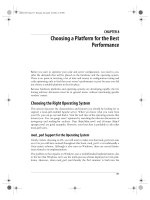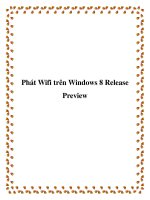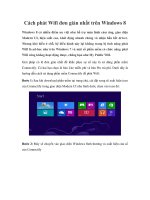MOB Subject 8 - WiFi Practical Traces Analyzes
Bạn đang xem bản rút gọn của tài liệu. Xem và tải ngay bản đầy đủ của tài liệu tại đây (76.59 KB, 3 trang )
1
MOB Subject 8 - WiFi Practical
Traces Analyzes
1. Configuration of a WiFi card
You will have to find the answers for these questions while searching on the Web.
1. What are two modes of connection allowed with WiFi?
2. What are different modes in which a WiFi card can be configured, and what do they
correspond to?
3. How do you configure a Wifi card under Linux to make it function in a network named
"TPMOB" in ad hoc mode or infrastructure, on a network having a shared key WEP "toto".
4. What are the parameters that one can modify during the configuration of the WiFi cards?
2. Traces Analyze
The traces has to analyze are to download from the folder:
/Infos/lmd/2004/master/ue/mob2005fev/Traces_sujet4/.
Trace 1
1. Which information can you obtain from this trace on the architecture (MAC Address
and IP of the implied stations in the exchanges, ad-hoc mode or infrastructure). How do
you identify the mode?
2. How many different IP packets were generated within the framework of this exchange?
3. Can one know if the recipient of ICMP packets is a mobile station or an AP?
4. Can one know the command which is of the origin of this exchange (between trace-route
and ping)? Why.
Trace 2
1. Which difference do you see with the preceding trace?
Trace 3
1. Which information of management is exchanged are in this trace and for what it serves?
2. How many AP do you see in the radio environment?
2
3. What are the flows supported by the different stations?
4. For this capture we tried to listen on only one channel in card configuring to listen on a
channel given. Which option of the iwconfi command did one use? The frame capture was
it done on only one channel?
5. Which information can you obtain from the exchanged beacon frames?
6. Which value is of the BSSID in ad hoc mode and infrastructure?
7. Identify the frames which do intervene as source or destination the station of which the
MAC address is 00:02:6f:09:3f:b0. Explain the frame exchanges in this cell.
Trace 4: 4a and 4b
1. Identify the stations concerned in the ICMP frames exchange of the traces 4a and 4b.
2. How do you explain these exchanges of packets ICMP.
Draw a diagram representative the exchange of implemented frames.
3. What is the difference between two traces concerning the exchanges of ICMP packets?
Explain the exchange of ICMP frames of the second trace.
Trace 5
1. How many were there retransmissions and does it concern to all the same stations?
2. Can one know if a retransmission is started in the causes of disruption on a wifi link
which corrupts a frame or in the causes of collisions?
Trace 6
1. This exchange shows exchanges of beacon frames, which difference do you see in
comparison with trace 3?
2. Which exchange of frames will allow the station whose MAC address is:
00:02:6f:09:3f:b0 to search others stations on the SSID "Test-captureTD " ?
3. What is the BSSID of this network and when is it exchanged (which frame) and on
which channel will be made the transmission? From which frame one sees that the stations
will be able to communicate?
3
4. Can one see the contents of the exchanged data? Why?









